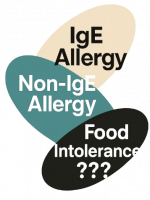
What Type of Allergy Do I Have?
No one ever told you it could be a typical food allergy, or a delayed-type allergy, or a food that just doesn’t agree. And an EpiPen only works for IgE Allergies
Key Takeaways:
- IgE-mediated allergies are true immune reactions with rapid, potentially life-threatening symptoms.
- Non-IgE mediated allergies are also immune reactions but delayed and typically affect the gut. They are generally not life-threatening.
- Food intolerances are non-immune reactions, often due to digestive issues, and are not life-threatening.
Accurate diagnosis by a healthcare professional (allergist or gastroenterologist) is crucial for proper management of these conditions. Self-diagnosis and self-treatment, especially for potential allergies, can be dangerous.
Articles
- Royal Childrens Hospital Melbourne
- American Academy of Allergy, Asthma & Immunology (AAAAI): “Non‑IgE Adverse Reactions to Foods”
- AAAAI Symposium: “Non-IgE-mediated Gastrointestinal Food …” (2016 VAM: 1806)
- Canadian Paediatric Society (CPS): “Non-IgE-mediated food allergy: Evaluation and management” (April 27, 2021)
- CPS: “Cow’s Milk Protein Allergy in Infants and Children” (June 25, 2024)
Feature | IgE-Mediated Allergy | Non-IgE Mediated Allergy | Food Intolerance |
Immune System Involvement | Yes, it involves IgE antibodies and mast cells. | Yes, involves other parts of the immune system (e.g., T-cells) but not IgE. | No, does not involve the immune system |
.Reaction Time | Rapid onset (minutes to 2 hours after ingestion) | .Delayed onset (hours to days after ingestion). | Variable, often within hours of ingestion. |
Severity | Can be severe, potentially life-threatening (anaphylaxis). | Generally not life-threatening, but can be very uncomfortable. | Generally not life-threatening, but can be uncomfortable. |
Common Symptoms | – Skin: Hives, itching, redness, swelling (angioedema), eczema | – Gastrointestinal: Vomiting (often profuse), diarrhea, abdominal pain, bloating, colic, constipation, poor weight gain, blood/mucus in stools | – Gastrointestinal: Bloating, gas, diarrhea, constipation, abdominal pain, nausea |
Examples of Conditions | Classic food allergies (e.g., peanut, tree nut, milk, egg, fish, shellfish, soy, wheat). | Food Protein-Induced Enterocolitis Syndrome (FPIES), Food Protein-Induced Allergic Proctocolitis (FPIAP), Eosinophilic Esophagitis (EoE). | Lactose intolerance, gluten sensitivity (non-celiac), histamine intolerance, FODMAPs intolerance. |
Diagnosis: | – Skin Prick Test (SPT): Immediate wheal and flare reaction. | Elimination Diet Removal of suspected food(s) followed by reintroduction. | – Elimination Diet: Keeping a food diary and then systematically removing and reintroducing foods. |
Management | – Strict avoidance of trigger food(s). | – Avoidance of trigger food(s). | – Dietary modification/reduction of problematic food/ingredient. |
Prognosis | Some allergies can be outgrown (e.g., milk, egg in children), but many are lifelong (e.g., peanut, tree nut). | Many non-IgE mediated allergies, especially in infancy (e.g., FPIES, FPIAP), are often outgrown by early childhood. | Often lifelong, but severity of symptoms can vary and management can improve quality of life. |
